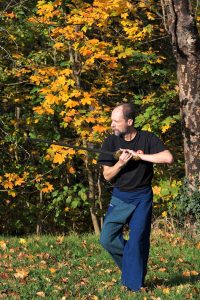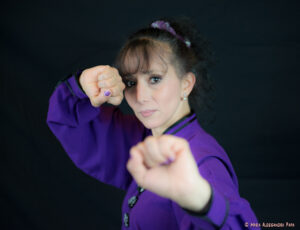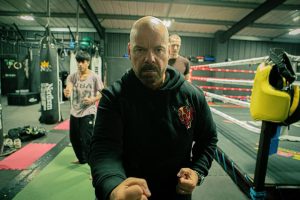From Monday to Thursday you can train for two and a half hours each morning and afternoon. Each day you can work on 2 separate disciplines (one from category A and one from category B) for 2.5 hours each, totalling 5 hours per day. This allows for 10 hours of intensive training in each of your chosen disciplines over 4 days. Please select one from each category.
 A1 – Mauro Bertoli
A1 – Mauro Bertoli
“Ba Men” the 8 doors: study of the fundamental forces of Taijiquan
The study of the fundamental forces of Taijiquan forms one of the central themes of the learning method in most traditional schools of Taijiquan.
Over the weekend we worked on the four main “gates”: Peng, Lu, Ji and An, analysing the four main forces according to Sifu Mauro Bertoli’s approach, looking for links between solo form and partner work.
During the week we will extend this analysis to the diagonal forces, the less studied but equally present and interesting: Cai(Tsai), Lie, Chou, Kao. We will try to go into more detail, using an approach that is open to the differences of the schools of origin but always adhering to the basic principles of Taijiquan.
Accessible to all
A2 – Frederic Plewniak 
Spirals and Sword Manipulation
This workshop invites you to discover and explore the role of spirals—twisting forces and spiralling movements—in the practice of Taijijian, from foundational basics to controlled and gentle partner work.
We will highlight the importance of spirals for:
- i) sword grip and guard postures;
ii) jiben jianfa (basic techniques);
iii) sensitivity to the partner (sensing the blade);
iv) fluidity in movements and technique sequences;
v) parrying, sword control, footwork and positioning in partner drills and martial applications.
Accessible to all
A3 – Gordon Faulkner 
Wudang Taiyi Wuxing Quan
The Supreme Oneness Five-element Fist is a unique Wudang boxing style. Its full name is “Wudang Supreme Oneness Five-Elements Capturing and Fighting 23 Styles” This is a small frame form that uses snake-like movement with force spiralling through the body. And as the name suggests, it contains grappling (Qinna) as well as striking techniques. It follows closely to the principles of the five-elements with bagua and nine-palaces stepping.
Taiyi, the supreme oneness, is the state where yin and yang are not yet separated to become Taiji. Therefore, Taiyi symbolises the transitional state that lies between Wuji (no extremes) and Taiji (great extremes).
Taiji forms try to maintain the balance and harmony of yin and yang, while Taiyi forms are more about the constant change and separation of yin and yang. That coordination internalises this concept into the action of Fajin, the explosive power extracted from the Taiyi principle to get the most power in a sequence. The constant change from relaxation to strength is key to understanding Fajin.
Accessible to all, although some previous experience would be beneficial
A4 – Yanira Rodriguez 
13 powers (Shi San Shi) Yang Style Tàijí Form
Fuxi’s legacy interprets the entire universe under the principles of yin-yang where:

This standard arrangement of Bagua (Fuxi’s pre-heaven) are the 8 powers built from yin and yang, which explain the origin of the universe, while from the intersections between yin and yang arise the 5 phases that teach us the structure of the universe.
Through the study and practice of the 13 powers (shi san shi) Tàijí form, we have the possibility to intimately understand and approach the balance of the universe and with it reach relaxation, silence and a deep connection with in ourselves.
Accessible to all.
B1 – Dee Swift
Introduction to Tai Chi Fan (Tai Ji Shan)
Tai Chi Fans will be provided or bring your own.
(Standard Fan – Total Length when folded = 13″ / 33cm)
We will cover
- The language of the fan, including the history of the fan in tai chi, and its martial and performance roots.
- Handling exercises for the fan – how to open and close it, its percussive qualities, and the multiple ways it can be used.
- A short sequence of single fan movements that can be practised alone or put together into a form.
- Basic partner exercises with the fan
Suitable for anyone with a little tai chi experience.
B2 – James Carss
The Sap Yi Than Sau of Han Xing Yuan 
They are:
- Sleeping dragon looking out from the hiding
- Heart striking baton
- Dragonfly dipping the water
- Snake crawling hand
- Rolling forearm while charging forward and retreating
- Circular/linking fist
- Wave riding fist
- Lion rolling a ball
- Bird can’t escape
- Double dip step
- Meteorite cannon
- Falcon stretching its wing
Simple techniques but containing a huge amount of depth and detail. We will explore and learn each one and their applications together with standing and footwork practices to improve structure, connection and power.
These 4 sessions are suitable for anyone regardless of background and you are welcome to drop in to some or all the sessions. The 12 techniques do not link together and you can learn some of the sets earlier or later parts.
Along with the obvious martial applications this practice is also very good for health and wellbeing.
Accessible to all
B3 – Paul Silfverstrale 
Tai Chi
Suitable for anyone with some tai chi experience.
B4 – Harriet Devlin
The Meaning and Movements of the Long Form
Over these four sessions we will explore the meanings and movements of the the Long Form . What do the symbols of the monkey, the tiger, the snake, the wild horse, the white bird, the magic bird, the lute, the jade maiden cloud arms and many others mean and how do they mirror one’s life journey ? We aim to cover the whole Long Form using imagery and breathing along with movement.
Accessible to all.
Copyright 2025 Tai Chi Caledonia | Privacy Policy